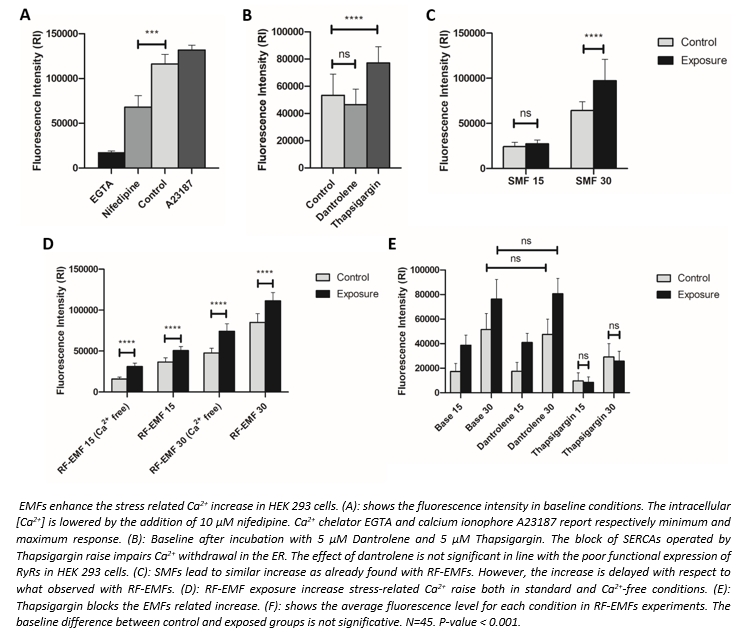A wide literature exists regarding the biological effects of various frequencies and intensities of electromagnetic fields (EMFs). These effects range from cellular proliferation to changes in expression and conduction of diverse types of ion channels. However, the major effect elicited by EMFs seems to be directed towards Ca2+ homeostasis. This is particularly remarkable since Ca2+ acts as a central modulator in various signalling pathways, including, but not limited to cell differentiation and survival. Despite the many evidence collected, however, the biological role of EMFs has yet to be unravelled and results reported in literature are often controversial due to variability of experimental parameters used, such as field intensity, level of exposure and model studied. Amongst the numerous pathways modulated by Ca2+, a particularly interesting role is played by stress response. This pathway is initiated within the endoplasmic reticulum (ER) and is critical for cell survival. ER stress is accompanied by alterations in Ca2+ homeostasis, and the depletion of internal Ca2+ store can induce cellular stress and apoptosis. Here, we assessed the effect of EMFs on the stress-elicited increase in intracellular [Ca2+], by activating HEK 293 ER stress response and exposing the cells to the radio-frequency electromagnetic fields (RF-EMFs) produced by a phone and to static magnetic fields (SMFs) generated by a magnetic coil. We detected a constant and time-dependent increase in intracellular [Ca2+] when medium changes were performed by aspirating and replacing fresh medium (stop-flow) as previously found in literature. Strikingly, this increase resulted to be significantly higher in the exposed group, already after 15 minutes of exposure. Similar results were obtained incubating cells with Ca2+-free solutions, suggesting the involvement of the ER intracellular Ca2+ stores in the detected increase. In line with this thinking, we targeted Ca2+ cytoplasmic enrichment and withdrawal using respectively Ryanodine receptor (RyRs) blocker Dantrolene and sarcoplasmic/endoplasmic reticulum Ca2+-ATPases (SERCAs) blocker Thapsigargin. Dantrolene treatment was proven to have no effect on this increase, consistent with the extremely low level of endogenous RyRs expression in HEK cells as previously proven by Western Blotting analysis. However, treatment with 5 μM Thapsigargin was sufficient to null the differences between exposed and control groups. The current results shed a light on the involvement of ER stress response on the modulation of EMFs effects. The internal [Ca2+] regulation by SERCAs is key for cell survival and, in fact, the blockage of SERCAs lead in short time to severe depletion of ER stores and cell death. The initial Ca2+ increase detected is in line with the blockage of Ca2+ withdrawal as with the activation of non-selective Ca2+-permeable cation channels triggered by depletion of intracellular stores. However, the rapid depletion of ER internal stores is enough to null the differences in intracellular [Ca2+] increase between the control and exposed groups, highlighting a direct modulation of ER Ca2+ efflux as a major effect of EMF exposure.
Physiology 2021 (2021) Proc Physiol Soc 48, OC78
Oral Communications: Thapsigargin blocks Electromagnetic fields-elicited intracellular Ca2+ increase in stress-response in vitro model
Federico Bertagna1, Rebecca Lewis1, Kamalan Jeevaratnam1
1 1Leverhulme Quantum Biology Doctoral Training Centre, University of Surrey, Guildford, Surrey, UK. 2School of Veterinary Medicine, Faculty of Health and Medical Sciences, University of Surrey, Guildford, Surrey, UK. , Guildford, United Kingdom
View other abstracts by:
Where applicable, experiments conform with Society ethical requirements.

